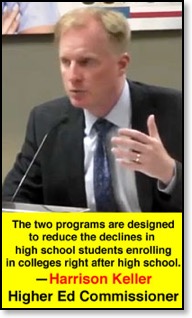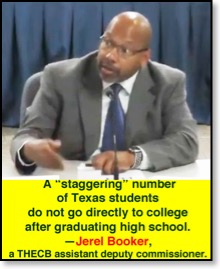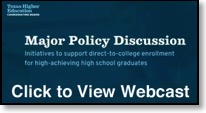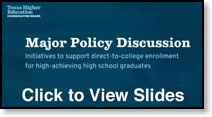New Initiatives seek to Halt Declines
In Top High School Grads Going to College
Encouraging more of Texas’ high achieving high school students to enter higher education institutions directly after graduating high school is the focus of two state-initiated programs that will launch soon.
The new programs were the focus of a staff briefing presented during a recent meeting of the governing board of the Texas Higher Education Coordinating Board (THECB).
Texas Higher Education Commissioner Harrison Keller said the programs are designed to help reverse the decline in the number of students who are enrolling in higher ed right after graduating high school (see graphics).
The idea, staff said, is to focus first on high achieving high school students — and giving all students info about what they will need to qualify for the two programs by the time they graduate high school.
Lori Fey, deputy THECB commissioner for data analytics, said that research reflects that students

Texas First
The first of the two new programs is the Texas First Early High School Completion Program, which will be known simply as Texas First.
The program is authorized by 2021’s SB1888/regular session and is designed to provide an incentive for students who have completed a high quality curriculum to graduate early from high school and then directly enroll in one of the 10 participating Texas universities.
Eligibility requirements include that a student must graduate under the Distinguished high school graduation plan, have a final GPA of at least 3.0 (on a 4.0 scale), and score high enough on college readiness assessments.
Eligible students will receive a scholarship credit — under a related Texas First Scholarship program — that is equivalent to a TEXAS Grant, which typically provides about $5,200 a semester, staff said.
The participating universities, per SB1888, are:
- UT Austin
- UT Arlington
- UT Dallas
- UT El Paso
- UT San Antonio
- Texas A&M
- Texas Tech
- Texas State University
- University of Houston
- University of North Texas
Staff said the program’s typical student would graduate high school six months to a year early. It’s possible that the first students to benefit from the program will likely graduate high school next December and go on to enroll at one of the 10 eligible institutions for the January 2023 semester.
Admission, however, is not guaranteed, because the student would have to meet the university’s admission requirements.
The proposed Texas First rules were posted in the Texas Register on April 29, and public comments are being accepted until May 29.
Commissioner Keller said he expects that a benefit of targeting students that graduate early is that it will eliminate the “brain drain” of out-of-state universities recruiting Texas high achieving students to their programs because these sought-after students will already be enrolled in a Texas institution.
Keller noted that more than 100 institutions from out of state have a presence in the D/FW area that are involved in aggressively recruiting Texas students to their programs.
The board discussed the possibility of asking the Legislature during its next session to allow more higher-ed entities, including community colleges, to participate.
Per SB1888, starting next school year, each public school must provide written notice to each high school student, and the student’s parent/guardian, listing the eligibility criteria for Texas First and the related scholarship program.
THECB’s governing board is expected to formally adopt the rules for the program at its July meeting, for a planned implementation date of Aug. 17.
Texas Leadership Scholars Program
The second program outlined by staff is the Texas Leadership Scholars Program that will target high-achieving “emerging leaders” who are low-income — with priority given to students who qualify as Top 10 Percent high school graduates.
Students accepted into this program will have 100 percent of their college tuition and fees covered through a combination of federal, state and institutional sources.
The program is being funded via an allocation provided by Gov. Abbott from federal Governor’s Emergency Education Relief (GEER) COVID-relief funding.
Student eligibility requirements include:
- Showing evidence of leadership and service within their high school and community.
- Demonstrating financial need, as evidenced by completion of the federal or state financial aid applications.
- Being eligible for a TEXAS Grant.
- Being accepted to a participating public four-year institution.
The program is expected to roll out on a two-year pilot basis, with 250 students accepted next fall, and another 250 students the fall after that. More details of this program are expected to be firmed up by this summer, staff said.
“Staggering” Data

Booker said that these students, despite doing everything they were supposed to do in high school to put them in the Top 10 percent category — and despite having the laws in place to support these students — “we’re still not seeing them in our higher-ed enrollments.”
Among the major discussion points during the briefing were observations that many students aren’t choosing to go to college after graduating high school because they have to work to support their families.
There was also discussion of the need to get school counselors — who are already likely to be overworked and under paid — on board, a process that could be difficult because, in some schools, there may be only one counselor per 300 or 400 students.
Staff said that the emphasis on notifying students and their parents about the programs will be made via initiatives to proactively contact them, and noted the extensive network the state has in place to provide online school counseling services.
Another issue mentioned as a barrier to high school graduates not enrolling in higher ed was the perception that a college education is not affordable, and would result in crippling student loan debt.
Keller cited data that more than half — 56 percent — of Texas students graduate college with no student loan debt.
To which THECB Board Chair Fred Farias III responded: “We’ve got to let people know that higher education is affordable.”

